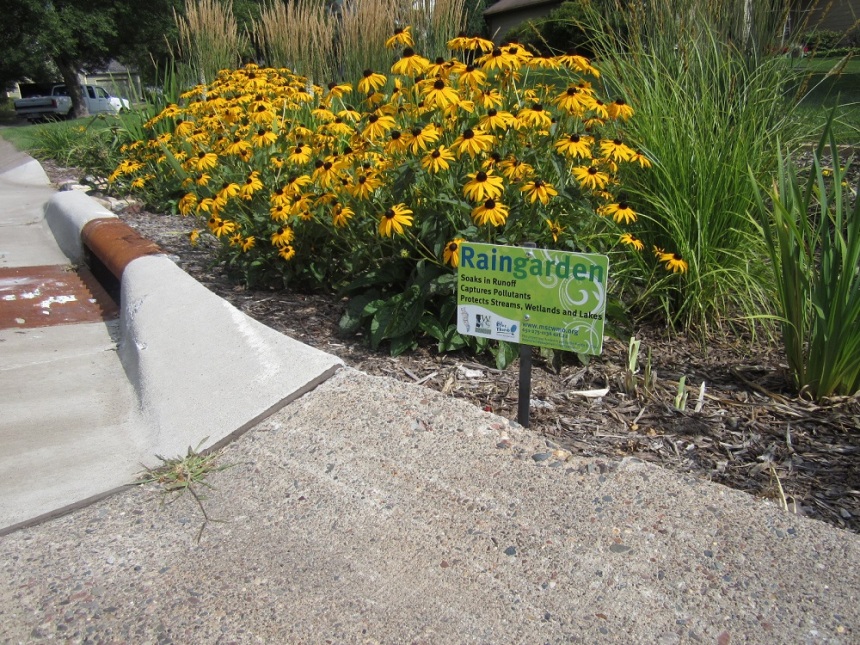A summer stroll through the neighborhoods of Stillwater is almost always lovely, thanks to the numerous historic sites, abundant Victorian architecture, bucolic tree-lined streets, and lavish gardens that decorate yards and boulevards. You may be surprised to learn that many of these gardens serve a dual purpose; in addition to being beautiful, they also help to clean and infiltrate stormwater runoff from rooftops and roads before it flows into the St. Croix River and lakes in town.

Known as raingardens, these gardens are typically situated along roadways or near the bottom of a downspout, and their job is to catch and hold rainwater until it soaks into the ground, is taken up by the plants, or evaporates. There are more than 330 raingardens in Stillwater, some of which are owned and managed by the city and other governmental entities, and others of which are located in the yards of private homes. Countywide, Washington Conservation District (WCD) has helped to install more than 1300 raingardens.
Raingardens help to reduce runoff water pollution and also replenish shallow groundwater aquifers. Beautiful as they are, people sometimes have misconceptions about how raingardens work and how to care for them.

Myth #1 – Raingardens are weed patches. Raingardens need to be weeded, just like any other garden, but when they are well maintained, they are beautiful. In Stillwater, staff from the WCD take care of most of the publicly owned raingardens in town, and Adopt-a-Raingarden volunteers provide additional support.
The WCD also helps people to design and install new raingardens and provides maintenance advice for raingarden owners. In general, raingardens should be weeded two to three times per year to keep the weeds at bay. In the spring, it’s important to remove sediment from raingarden inlets and clear out dried vegetation, leaves, and litter. You can find additional raingarden maintenance information online at www.mnwcd.org/adoptaraingarden.

Myth #2 – Raingardens attract mosquitoes. When properly designed and installed, raingardens absorb water within one to two days, leaving no time for mosquito eggs to hatch. In fact, the vast majority of the time, raingardens are completely dry like any other garden.

Myth #3 – Raingardens are only for people who live near the water. Rain and melting snow carry dirt, litter and contaminants through ditches and stormwater pipes to lakes and rivers that can be miles away. Raingardens help to keep some of that water out of the storm sewer system so that less pollution reaches our lakes and rivers. Every drop counts, whether it falls ten feet or ten miles from the edge of the water.

Myth #4 – Raingardens are the solution to our water pollution problems. Nonpoint source runoff is the number one source of pollution to Minnesota’s lakes and rivers. While raingardens can help to address this problem in urban and suburban areas, they are just one of many tools and strategies needed to keep our water clean. Raingardens can not be built in places where there is shallow bedrock, where the soil is always or usually wet, on top of buried utilities, or next to the foundation of a building. They remove sediment and nutrients from runoff during small rainstorms but don’t provide much protection against flooding when there is more than two-inches of rain. In conjunction with other green infrastructure practices, however, raingardens help to restore natural hydrology, create pockets of habitat for birds and pollinators, and filter sediment and nutrients out of stormwater runoff.

For more information on raingardens, visit www.BlueThumb.org. To request a free site visit in Washington County (MN), learn about cost-share grants, and get help with raingarden planning, design, and installation, visit: www.mnwcd.org.
If you’d like to learn more about raingardens and rainwater harvesting, I will be giving a presentation for Friends of Scandia Parks and Trails on Tuesday, June 13, 7-8pm at Scandia Community Center (14727 209th St N, Scandia, MN 55073). The event is free and open to everyone.
